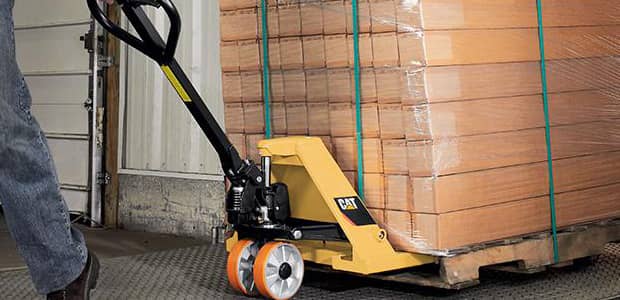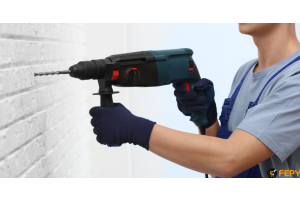What is a Pallet Truck? Definition, Types, and Uses Explained

A pallet truck, also known as a pallet jack, is a manual or electric tool used to move palletized loads within a warehouse or other industrial setting. It typically consists of two forks that slide under the pallet, and a hydraulic jack that lifts the load slightly off the ground for transport.
Pallet trucks are ideal for short distance transportation and can handle loads up to several tons. They are versatile, easy to maneuver, and can improve efficiency in a warehouse setting.
What is a Pallet Truck?
Pallet trucks are also known as pallet jacks or pump trucks. They are indispensable tools in the world of material handling. They provide a convenient and efficient way to move and transport heavy loads on pallets within warehouses, construction sites, factories, and various other settings.
Pallet trucks are designed to simplify the process of loading, unloading, and transporting goods, ultimately enhancing productivity and reducing manual effort.
In this article, we will explore the different types of pallet trucks available in the market, their specific uses, how to choose the right one for your needs, and essential guidelines for using them safely and effectively.
Different Types of Pallet Truck and Their Uses
A. Manual Pallet Trucks
Manual pallet trucks are the most common and widely used type of pallet truck. They are operated by hand, utilizing a hydraulic pump mechanism to lift the load off the ground. Manual pallet trucks are known for their simplicity, durability, and ease of use.
They are suitable for a wide range of applications, from small businesses to large warehouses. These versatile tools are ideal for moving palletized loads within confined spaces and are particularly beneficial for homeowners, construction industry professionals, and procurement managers who need to transport goods efficiently.
Hand pallet trucks, a subtype of manual pallet trucks, are designed to be operated manually without the need for any external power source. They are cost-effective and require minimal maintenance, making them a popular choice for various industries.
B. Electric Pallet Trucks
Electric pallet trucks, powered by an electric motor, offer enhanced convenience and efficiency compared to manual counterparts. These trucks are designed to handle heavier loads and cover longer distances with ease.
Electric pallet trucks are suitable for larger warehouses, distribution centers, and industrial settings where productivity and speed are crucial. They are commonly equipped with advanced features such as electronic controls, ergonomic handles, and improved maneuverability.
Homeowners, civil engineers, and construction project managers can benefit from electric pallet trucks when handling heavy loads and optimizing workflow.
C. Rough Terrain Pallet Trucks
In construction sites and outdoor environments, rough terrain pallet trucks are invaluable tools. These specialized trucks are built to handle rugged surfaces, uneven terrains, and challenging outdoor conditions. With larger wheels, robust frames, and enhanced stability, rough terrain pallet trucks provide reliable performance and maneuverability on gravel, dirt, and other rough surfaces.
They are commonly used in the construction industry to transport construction materials, equipment, and supplies across job sites. Interior decorators and individuals involved in outdoor events can also benefit from these trucks when setting up or dismantling event structures and carrying bulky items.
D. Scissor Lift Pallet Trucks
Scissor lift pallet trucks combine the functionality of a pallet truck and a scissor lift. They are equipped with a scissor-like mechanism that allows the lifting platform to be raised to various heights. This feature enables efficient and ergonomic handling of goods at different levels, eliminating the need for additional lifting equipment or platforms.
Scissor lift pallet trucks are commonly utilized in industries where frequent lifting and positioning of loads at different heights are required, such as warehouses, manufacturing facilities, and retail environments.
These trucks are highly versatile and can significantly improve productivity for homeowners, procurement managers, and interior decorators dealing with varied load elevations.
E. Pallet Stacker Trucks
Pallet stacker trucks, as the name suggests, are designed to stack pallets vertically, maximizing storage space in warehouses and storage facilities. They are equipped with an adjustable mast and forks that allow for precise stacking of pallets.
Pallet stacker trucks are commonly used in industries that require efficient utilization of vertical space, such as logistics, distribution centers, and retail warehouses.
By using pallet stacker trucks, homeowners and construction industry professionals can optimize their storage capabilities and effectively manage inventory.
F. Weighing Pallet Trucks
Weighing pallet trucks come with integrated weighing systems that allow for accurate weighing of loads during the handling process. These trucks eliminate the need for separate scales or weighing equipment, streamlining operations and enhancing efficiency.
Weighing pallet trucks are particularly useful in applications where precise weight measurements are critical, such as shipping and logistics. They ensure accurate load distribution, compliance with weight restrictions, and efficient inventory management.
Procurement managers and civil engineers involved in transportation and logistics can greatly benefit from the convenience and accuracy offered by weighing pallet trucks.
G. Considering Specialized Requirements
In addition to the aforementioned types of pallet trucks, there are specialized pallet trucks designed to meet specific industry requirements.
For example, cold storage pallet trucks are built to withstand low-temperature environments, making them suitable for freezer rooms and cold storage facilities. Explosion-proof pallet trucks are designed for hazardous areas where the risk of explosions or fire is present, such as chemical plants or oil refineries. Narrow aisle pallet trucks are engineered to operate in tight spaces with limited maneuverability, allowing for efficient handling in narrow aisles and congested areas.
How to Choose the Right Pallet Truck
One of the most critical considerations is determining the weight capacity required for your specific applications. Evaluate the maximum weight of the loads you typically handle to ensure that the chosen pallet truck can accommodate those loads safely and efficiently. It's important to consider both the maximum load capacity and the load center, as these factors directly impact the stability and maneuverability of the pallet truck.
The operating environment plays a crucial role in choosing the right pallet truck. For indoor use, standard pallet trucks are suitable, while rough terrain pallet trucks are better suited for outdoor applications. Consider the surface conditions, such as smooth warehouse floors or rough construction sites, and select a pallet truck that can withstand and navigate those conditions effectively.
Ergonomics is an essential aspect to consider, as it directly affects the comfort and safety of the operators. Look for pallet trucks with ergonomic handle designs, adjustable controls, and features that reduce strain and fatigue. Additionally, user-friendly features like easy maneuverability, smooth lifting and lowering mechanisms, and intuitive controls can enhance productivity and efficiency.
Budget is always a factor when making equipment choices. While quality and reliability should not be compromised, there are affordable options available in the market, such as cheap pallet trucks, that offer reliable performance at a lower price point. However, it's important to balance cost with quality and ensure that the pallet truck meets safety standards and durability requirements.
Durability is paramount, especially when considering heavy-duty applications and challenging environments. Opt for pallet trucks constructed with high-quality materials, robust frames, and durable components. Regular maintenance and servicing are also essential to ensure the longevity and optimal performance of the pallet truck. Proper lubrication, inspections, and timely repairs contribute to the safe and efficient operation of the equipment.
How to Use a Pallet Truck
To utilize a pallet truck safely and efficiently, it is crucial to follow proper operating procedures. Here's a step-by-step guide to using a pallet truck:
Safety Precautions and Training
Before operating a pallet truck, operators should receive adequate training on safety protocols and familiarize themselves with the specific features and controls of the equipment. They should wear appropriate personal protective equipment (PPE), such as safety shoes and gloves, to prevent injuries.
Step-by-Step Guide to Operating a Pallet Truck
Preparing the Pallet and Load:
a. Ensure that the pallet is in good condition without any damaged or broken boards.
b. Position the pallet truck next to the pallet, aligning the forks with the openings between the pallet boards.
c. Lower the forks completely to the ground before inserting them into the pallet.
Maneuvering the Pallet Truck Safely:
a. Grasp the handle firmly and engage the brake, if available.
b. Begin pushing or pulling the handle to navigate the pallet truck smoothly.
c. Maintain clear visibility of the path and ensure there are no obstacles or obstructions in the way.
Lifting, Transporting, and Lowering the Load:
a. Engage the lifting mechanism by pumping the handle to raise the forks off the ground.
b. Lift the load just high enough to clear the ground and ensure stability.
c. Slowly and carefully maneuver the pallet truck to transport the load to the desired location.
d. When ready to lower the load, release the pressure on the handle to activate the lowering mechanism gradually.
Tips for Optimal Performance and Efficiency
To maximize the performance and efficiency of a pallet truck, consider the following tips:
- Position the load evenly on the forks to maintain stability during transportation.
- Take advantage of the maneuverability of the pallet truck to navigate corners and tight spaces efficiently.
- Avoid overloading the pallet truck beyond its specified capacity to prevent accidents and damage to the equipment.
- Regularly inspect the pallet truck for any signs of wear or damage and report any issues to the appropriate personnel.
Advanced Techniques for Maneuvering and Turning in Confined Spaces
In confined spaces, it may be necessary to utilize advanced techniques for maneuvering and turning the pallet truck. These techniques include:
- Three-point turns: When navigating tight corners or narrow aisles, perform three-point turns by reversing the pallet truck in an arc. This allows for better maneuverability and minimizes the risk of collisions or damage to the surroundings.
- Pivot turns: In extremely confined spaces, use pivot turns to change direction. Keep one fork planted on the ground while rotating the other fork and the rear wheels in the desired direction.
- Side shifting: Some pallet trucks are equipped with side-shifting capabilities, which enable lateral movement of the load. This feature can be beneficial when aligning the load with shelving or racks in narrow aisles.
Safety Tips for Working with Heavy-Duty Loads
When working with heavy-duty loads, it is essential to prioritize safety. Consider the following tips:
- Ensure that the load is within the weight capacity of the pallet truck and properly balanced on the forks.
- Use caution when lifting heavy loads, ensuring that the forks are fully inserted into the pallet and the load is secure.
- Maintain clear visibility while transporting heavy loads and be aware of any potential obstacles or hazards in the surroundings.
- Use team lifting techniques or seek assistance when handling exceptionally heavy loads to prevent strain or injuries.
Troubleshooting Common Issues and Maintenance Tips
To keep the pallet truck in optimal condition, regular maintenance is necessary. Some common issues that may arise include:
- Fork misalignment: Check the forks for any misalignment or damage and realign or replace them as needed.
- Hydraulic system leaks: Inspect the hydraulic system regularly for any signs of leakage, and promptly address and repair any leaks to maintain proper functioning.
- Wheel issues: Check the wheels for wear, damage, or obstructions, and ensure they are properly lubricated and aligned.
- Battery maintenance (for electric pallet trucks): If using electric pallet trucks, maintain and recharge the batteries as recommended by the manufacturer to ensure optimal performance.
Conclusion
Pallet trucks are essential tools for homeowners, construction industry professionals, procurement managers, civil engineers, construction project managers, interior decorators, and anyone involved in the construction business.
By understanding the different types of pallet trucks available, their specific uses, how to choose the right one, and following proper operating procedures, individuals can improve efficiency, enhance productivity, and ensure safety in material handling operations.
Remember to explore reliable sources for purchasing pallet trucks, such as reputable suppliers and distributors, including options like pallet trucks available in Dubai. Stay informed about emerging technologies and innovations in pallet truck design that can further enhance efficiency and productivity in the ever-evolving construction industry.





